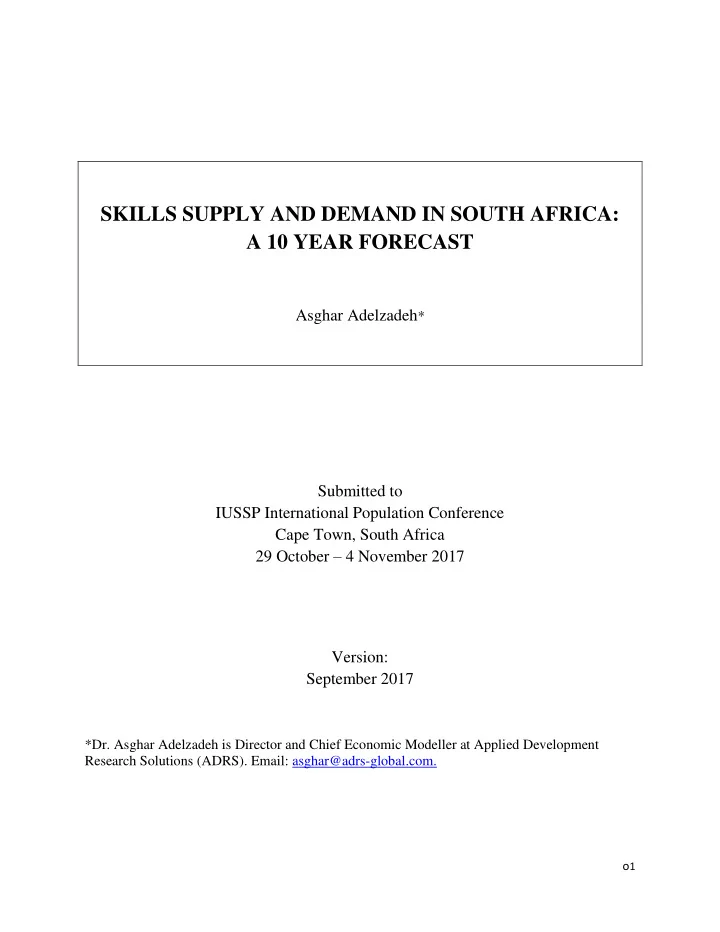

SKILLS SUPPLY AND DEMAND IN SOUTH AFRICA: A 10 YEAR FORECAST Asghar Adelzadeh * Submitted to IUSSP International Population Conference Cape Town, South Africa 29 October – 4 November 2017 Version: September 2017 *Dr. Asghar Adelzadeh is Director and Chief Economic Modeller at Applied Development Research Solutions (ADRS). Email: asghar@adrs-global.com. o 1
SKILLS SUPPLY AND DEMAND IN SOUTH AFRICA: A 10 YEAR FORECAST Abstract Until recently, South Africa did not have a comprehensive system to produce consistent projections of skills and occupations. The Linked Macro-Education Model of South Africa (LM-EM) provides a platform to design economic, labour force, and education policy scenarios, quantify their impact, and forecast trends in economic indicators and the demand and supply of skills. The model has a modular architecture that includes a multi-sector macroeconometric model and seven skills demand and supply modules. Cointegration techniques (Pesran 1997) were used to estimate the more than 400 behavioural equations of the macro module and multinomial logistic regression techniques (Homer and Lemeshow, 2000) were used for the estimation of occupational demand, qualification demand and labour supply. Finally, the cohort component approach (George et al, 2004) was used to estimate the net replacement demand. The model forecasts key macroeconomic and industry indicators, employment for 45 economic sectors, job openings, and job seekers by occupation and qualification. This paper provides an overview of the LM- EM’s structure, data source and empirical methodologies, and present s the model’s results for three alternative Low, Medium, and High growth scenarios for the next 10 years that includes the likely future trends in labour force, demand and supply of skills and occupations. Key Words: skills demand, skills supply, economic model, Education model, South Africa, skills gap, skills planning. o 2
SKILLS SUPPLY AND DEMAND IN SOUTH AFRICA: A 10 YEAR FORECAST 1. INTRODUCTION ........................................................................................................................................ 4 2. LITERATURE REVIEW ............................................................................................................................ 5 3. STYLIZED FACTS ..................................................................................................................................... 5 3.1. 5 Occupation Patterns of Employed ........................................................................................................... 3.2. 10 Educational Qualification Patterns of Employed .................................................................................. 3.3. 16 Labour Force ......................................................................................................................................... 4. DATA ISSUES ........................................................................................................................................... 19 5. ..................................................................................................................................... 20 METHODOLOGY 5.1. 20 Design Techniques ................................................................................................................................. 5.2. 23 Empirical Techniques ............................................................................................................................ 5.2.1. Time Series Analysis ......................................................................................................................................... 23 5.2.2. ......................................................................................................................................... 25 Survey Data Analysis 5.2.2.1. Occupation Demand Methodology ........................................................................................................... 27 5.2.2.2. Qualification Demand Methodology ........................................................................................................ 28 5.2.2.3. Labour Force Projection Methodology ..................................................................................................... 29 5.2.2.4. Replacement Demand Methodology ........................................................................................................ 30 5.3. 33 Simulation Technique ............................................................................................................................ 6. MODEL OUTPUTS AND VALIDATION ................................................................................................ 34 7. LM-EM: A 10 YEAR FORECAST OF SKILLS SUPPLY AND DEMAND ........................................... 35 7.1. 37 Macroeconomic Outlook ........................................................................................................................ 7.1.1. Growth ............................................................................................................................................................... 37 7.1.2. ....................................................................................................................................................... 37 Employment 7.1.3. Employment by Occupation (2015-2025) .......................................................................................................... 38 7.1.4. Employment by Qualification (2015-2025) ........................................................................................................ 38 7.2. Job Openings .......................................................................................................................................... 39 7.2.1. Job Openings by Occupation (2015-2025) ......................................................................................................... 40 7.2.2. Job Openings by Qualification (2015-2025) ....................................................................................................... 41 7.3. 42 Job Seekers ............................................................................................................................................. 7.3.1. Labour Force Projection (2015-2025) ................................................................................................................ 42 7.3.2. .......................................................................................................... 43 Job Seekers by Qualification (2015-2025) 7.3.3. ............................................................................................................ 44 Job Seekers by Occupation (2015-2025) 7.4. 44 Labour Market Imbalances .................................................................................................................... 7.4.1. Skills Gap (2015-2025) ....................................................................................................................................... 45 7.4.2. Unemployment Rate (2015-2025) ..................................................................................................................... 46 8. .................................................................................... 47 FINAL REMARKS AND RECOMMENDAIONS 9. REFERENCES .......................................................................................................................................... 50 o 3
Recommend
More recommend